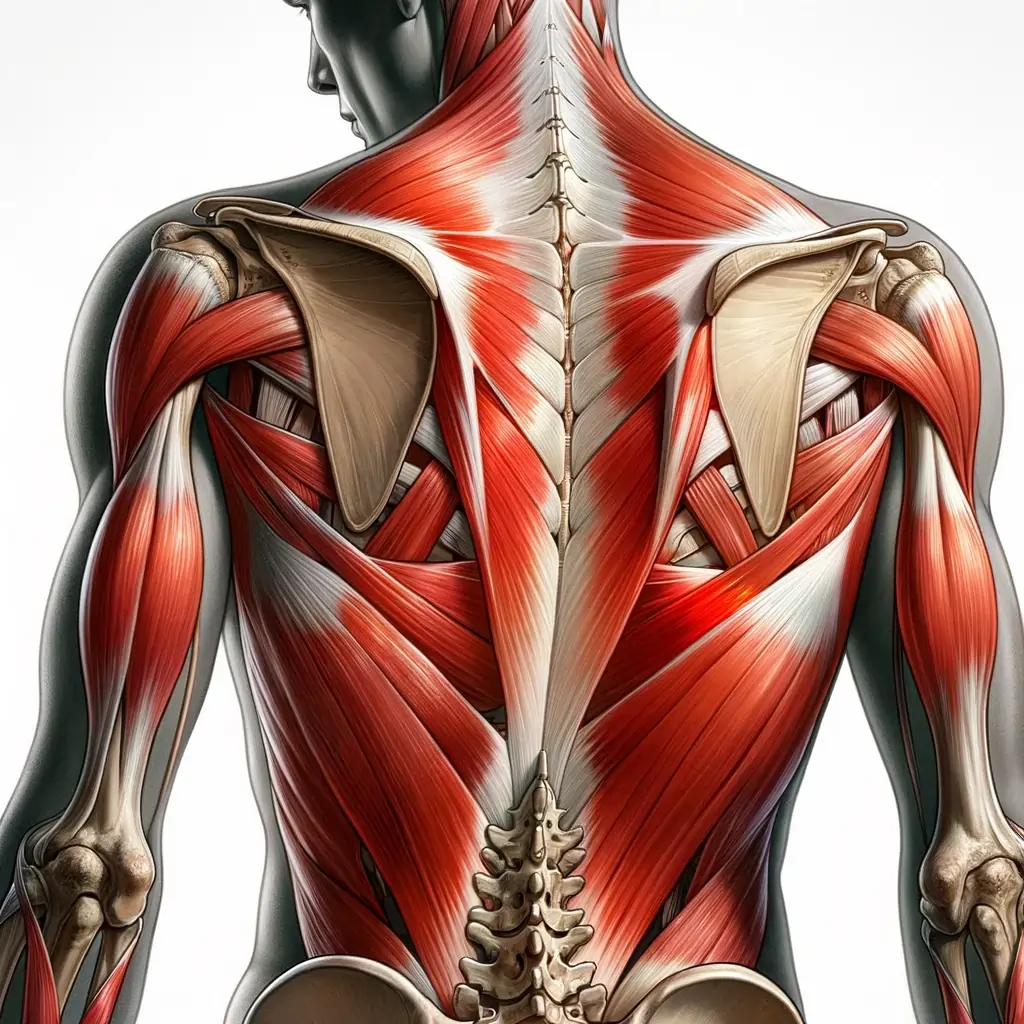Best Sleeping Position For Latissimus Dorsi Pain

Latissimus dorsi pain can turn a good night’s sleep into a struggle. This muscle, stretching across your back and helping in movements like pulling or lifting, is key for many daily activities.
When this important muscle aches, finding comfort at bedtime becomes crucial. Side sleeping on the non-painful side with your legs straight and a pillow between them could be the relief you need, aligning your spine and reducing strain.
Back sleeping also offers advantages; placing a soft pillow under the lower back supports those critical attachment points of the latissimus dorsi muscle.
If discomfort persists despite these adjustments, visiting a doctor is essential to rule out other issues that could be causing pain. In addition to restful sleep positions, treatments like neuromuscular therapy offer extra layers of relief by targeting specific trigger points in the muscle tissue.
Regular massages and targeted exercises such as yoga may also fortify your back muscles over time.
This article unfolds vital knowledge about latissimus dorsi pain while guiding you through various sleep position strategies designed for optimum comfort. Unlock better nights’ rest with insights that cater not just to immediate ease but long-term well-being too.
Get ready for improved slumber without any twists or turns!
Key Takeaways
- Side sleeping can help with latissimus dorsi pain. Use a firm mattress, keep your legs straight, and place a pillow between your knees to align your spine.
- Lying on your back is also beneficial. Put a pillow under your knees and keep arms relaxed at your sides for spine support without adding tension to the lats.
- Neuromuscular therapy may offer targeted relief by treating trigger points and enhancing muscle recovery in the latissimus dorsi.
- For additional comfort during sleep, avoid placing arms above the head or twisting at the waist as this can increase muscle tightness in the lats.
- Incorporate stretches and strengthening exercises into daily routines to improve posture, reduce strain on muscles, and prevent development of painful trigger points.
Understanding the Latissimus Dorsi and Its Function

Diving deep into the anatomy of your back, you’ll find that the latissimus dorsi is a key player in various upper body movements; it’s essential to comprehend its role to effectively address any discomfort you might feel.
This expansive muscle spans from your lower back up to the armpits, playing a pivotal part in actions like pulling or lifting—understanding how it functions sets the stage for recognizing why certain sleeping positions can mitigate pain and promote healing.
Latissimus Dorsi Trigger Points
Trigger points in the latissimus dorsi muscle can cause discomfort and pain that radiates throughout the back. These knots develop due to factors like overuse, injury, or tension and require specific techniques for relief.
- Locate trigger points by feeling for tender spots or tightness along the inside edge of the shoulder blade, where the latissimus dorsi attaches.
- Use a foam roller or a firm ball to apply gentle pressure and massage these areas to help alleviate pain and ease muscle tightness.
- Engage in stretches that specifically target the latissimus dorsi, such as extending your arms overhead or clasping your hands behind your back to open up the chest.
- Incorporate strengthening exercises that work on improving posture and reducing strain on the lats, which may involve rows or pull-down motions.
- Practice good posture throughout the day to prevent further development of trigger points caused by slouching or prolonged sitting.
- Consider seeking neuromuscular therapy from a professional who can use precise techniques to release these knots and advise on preventive measures.
- Maintain regular movement patterns and adjust any repetitive activities that could contribute to the formation of painful trigger points in this large back muscle.
- If sleeping positions aggravate these trigger points, place a pillow under your arm for support while side sleeping or beneath your knees when lying on your back.
- Self – massage routines before bedtime might be beneficial; gently rub around and directly on top of painful areas to reduce discomfort during sleep.
Causes of Latissimus Dorsi Pain

Repeated motions and a strenuous workout regime often lead to latissimus dorsi pain, especially if you frequently engage in activities like swimming, baseball pitching, or golfing.
These sports require continuous use of the latissimus dorsi muscle which can become overworked and tight, resulting in discomfort and muscle pain. Improper form during exercise or lifting heavy objects without proper support can also strain this large back muscle.
Your pain might also stem from non-athletic issues such as poor posture while sitting for extended periods or sleep on your side incorrectly. A pinched nerve near the lumbar spine could radiate pain through the latissimus dorsi due to its proximity to various nerves and its role in connecting the upper body to the lower back.
Additionally, underlying conditions like osteoarthritis may contribute to persistent upper back pain by causing joint inflammation that aggravates nearby muscles including the lats.
Importance of Consulting a Doctor for Pain Assessment
When you experience pain in the latissimus dorsi, it’s essential to seek medical advice. A doctor can identify whether your discomfort is due to common causes like overuse or if there’s a more serious condition at play, ensuring that your treatment plan is safe and effective for your specific needs.
Rule out potential underlying pathology
If you’re feeling pain in your latissimus dorsi, it’s essential to consult a doctor to rule out any deeper issues. While the discomfort could be due to overuse or strain from activities like swinging a baseball bat or golf club, there may be other causes at play.
Your physician will conduct a thorough assessment, possibly including diagnostic tests, to ensure that no underlying pathology is causing your symptoms. These conditions might require different treatment options and could have implications for overall health.
Visiting a healthcare professional helps prevent misdiagnosis of conditions that mimic latissimus dorsi pain but stem from other issues such as rotator cuff tears or problems with the quadratus lumborum.
The goal is not only to reduce pain and restore back strength but also to safeguard against potential complications by addressing any preexisting factors associated with shoulder pain and difficulty breathing.
Proper evaluation ensures you receive the best approach for relief tailored specifically to your situation – this could include specific exercises, rest routines, or further medical referrals if necessary.
Exploration of Sleep Positions for Latissimus Dorsi Pain Relief
Discovering the optimal sleep position is key to nighttime latissimus dorsi pain relief, so let’s delve into how adjusting your slumber posture can help alleviate discomfort and promote healing in this crucial back muscle.
Side Sleeping Recommendations
Side sleeping can offer significant pain relief for your latissimus dorsi and help maintain proper alignment of your spine. This position may also prevent discomfort in the lower back and facilitate better breathing while you rest. Here are a few recommendations to optimize side sleeping for latissimus dorsi pain relief:
- Choose a firm mattress that supports the natural curve of your body without allowing your hips or shoulders to sink too deeply.
- Position yourself so that your legs are straight, which is recognized as the second – best posture for minimizing both back and neck pain.
- Place a pillow between your knees to foster spinal alignment, reducing pressure on your hips and promoting an even distribution of weight.
- Opt for a supportive pillow under your head, ensuring it fills the space between your shoulder and neck to avoid straining these areas.
- Hug a pillow with your arms if necessary; this can mimic the beneficial effects of certain exercises, providing gentle stretching that helps relieve tightness in the latissimus dorsi.
- Keep your top arm parallel to your body or slightly forward to limit stress on the shoulder joint, avoiding potential injuries to the latissimus dorsi.
- Avoid twisting at the waist or curling up too tightly as these positions can lead to more tension in the lats and discomfort upon waking.
- Adjust by slightly flexing your knees if straight legs become uncomfortable. This modification still allows for reduced strain on vital muscle groups.
Back Sleeping Recommendations
Transitioning from side sleeping, let’s examine how resting on your back can play a pivotal role in alleviating latissimus dorsi pain. This position, recommended by experts, can help align your spine and relieve pressure on your upper and lower back.
- Lie flat on your back with a neutral spine to reduce strain on the latissimus dorsi. Ensure that your head rests comfortably on a pillow that supports the natural curve of your neck.
- Place a pillow beneath your knees to maintain a slight bend. This position helps promote spinal alignment and can prevent lower back pain by reducing the stress on the lumbar region.
- Keep your arms relaxed at your sides or place them gently on your stomach. Avoid raising them above your head as this can increase tension in the latissimus dorsi and lead to discomfort.
- Use a mattress that provides adequate support for your body weight without sagging. A firmer surface often works well for back sleepers because it keeps the spine aligned properly throughout the night.
- Consider positioning a small, rolled – up towel under the small of your back for extra support if you encounter any gaps between the mattress and your lower spine.
- Avoid using overly thick pillows which could angle your head too far forward, potentially causing additional strain on both upper and lower muscles in the back.
Neuromuscular Therapy for Additional Pain Relief
Neuromuscular therapy, a precise massage modality, targets your Latissimus Dorsi pain by manipulating the muscle’s soft tissue to relieve tension and enhance recovery.
Neuromuscular Therapy techniques for pain relief
Neuromuscular therapy offers targeted relief for those struggling with latissimus dorsi pain. This specialized form of massage addresses muscular and nervous system disorders, often leading to significant pain reduction and improved body function.
- Identify and treat trigger points: Therapists locate tender areas where muscle fibers have tensed up, then apply pressure and manipulate these spots to ease discomfort in the latissimus dorsi.
- Implement myofascial release techniques: By gently stretching and releasing the fascia around muscles, therapists improve blood flow and flexibility, helping relieve pain.
- Encourage proper breathing: During treatment, you’ll be guided through specific breathing exercises that can enhance the effectiveness of neuromuscular therapy by relieving muscular tension.
- Utilize muscle energy techniques (METs): This involves you actively contracting muscles against a therapist’s resistance, which helps normalize joint function and reduce lats pain.
- Apply soft tissue mobilization: Through specific movements applied to muscles and other soft tissues, therapists can help break down adhesions that contribute to your discomfort in the latissimus dorsi.
- Perform corrective exercises: After neuromuscular therapy sessions, certain exercises may be prescribed to strengthen weak areas and prevent latissimus dorsi pain from returning.
Conclusion
As you seek comfort and relief from latissimus dorsi pain, remember that your sleeping posture plays a crucial role. Opting for side sleeping with a supportive pillow can make a significant difference in how you feel each morning.
Ensure proper alignment of your body to prevent discomfort throughout the night. Embrace routines like staying hydrated and incorporating specific yoga exercises to strengthen and relax your muscles.
Prioritize these practices nightly, and you may discover a more restful sleep, free from the grip of latissimus dorsi pain.
Sam Visnic
Most Popular Posts
Categories
- Deep Gluteal Pain Syndrome (8)
- Deltoids (2)
- Foam Rolling (2)
- Glutes (9)
- Hamstrings (5)
- Hypnosis for Pain (3)
- Lats (2)
- Levator Scapulae (4)
- Lifestyle (8)
- Massage Therapy (39)
- Mobility (21)
- Movement and Exercise (19)
- Muscles (22)
- Nutrition (2)
- Obliques (1)
- Pain (25)
- Pectorals (3)
- Piriformis (3)
- Plantar Fasciitis (11)
- Psoas (11)
- Quadratus Lumborum (3)
- Quadriceps (2)
- Rhomboids (3)
- Sciatica (1)
- Serratus Anterior (1)
- SI Joint (14)
- Sternocleidomastoid (1)
- Stretching (18)
- Subscapularis (1)
- TMJ (2)
- Trapezius (1)
- Uncategorized (12)







